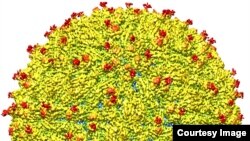Researchers have determined the structure of the Zika virus.
The “near-atomic level map” shows Zika to be similar to the dengue virus, and other flaviviruses.
The one key difference lies in a “key surface protein,” according to research funded by the National Institute of Allergy and Infectious Diseases.
The discovery could lead to a better understanding of how the virus works in the human body, which in turn, could lead to better drugs and vaccines.
Researchers said that the variation in the E glycoprotein of the Zika virus could explain the “ability of the virus to attack nerve cells, as well as the associations of Zika virus infection with birth defects and the autoimmune-neurological Guillian-Barré syndrome.”
Created by researchers at Purdue University, the map was done by freezing particles of the virus and shooting high-energy electrons to create “tens of thousands of two-dimensional electron micrograph images that are then combined to yield a composite high-resolution, three-dimensional view of the virus.”
Scientists have known about Zika since it was discovered in Uganda in 1947, but only recently have realized its potential danger.
Starting in October, the mosquito-borne virus began to spread, particularly in Brazil, where it has been potentially linked to a birth defect called microcephaly, in which fetal brains are abnormally small.








